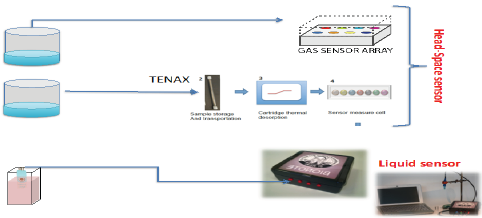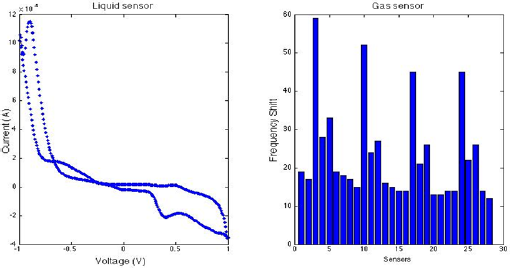- Submissions

Full Text
Significances of Bioengineering & Biosciences
A Sensor Multiplatform for Non Invasive Diagnosis of Prostate Cancer
A D'Amico1*, M Santonico2, G Pennazza2, Y Cavalieri3, G Farullo3 and Enrico Finazzi Agrò4
1Department of Electronic Engineering -University of Rome "Tor Vergata’’ -Via del Politecnico 1,00133, Roma
2Unit of Electronics for Sensor Systems-Department of Engineering-University of Campus Bio-Medico di Roma-Via Alvaro del Portillo, 21-00128, Roma
3Urology Specialization Medicine-University of Rome "Tor Vergata"
4Department of Surgical and Experimental Medicine-University of Rome "Tor Vergata"
*Corresponding author: A D'Amico, Department of Electronic Engineering -University of Rome "Tor Vergata” -Via del Politecnico 1,00133, Roma
Submission: November 13, 2017; Published: February 22, 2018

ISSN 2637-8078Volume1 Issue2
Abstract
This work underlines the utility of a multiplatform based on the use of both artificial olfaction and taste systems that show the ability to perform both gas and bio liquid chemical imaging. Preliminary results related to the investigation of prostate cancer suggest that high performance levels with diagnostic and screening purposes can be reached with non invasive experimental procedures.
Introduction
Prostate cancer (PCa) is the most common tumor among male solid tumors [1]. Diagnosis of PCa is based on digital rectal examination (DRE), prostate-specific antigen (PSA) blood test, and transrectal ultrasound-guided (TRUS) biopsy of the prostate [2]. Screening for early detection of PCa represents one of the most debated topics in scientific literature [3]. In the last decades, the use of PSA as the standard screening method in population has led to a reduction in advanced disease at diagnosis and PCa-related mortality but also to a large increase in the number of unnecessary prostate biopsies [4]. Serum level of PSA also raises in other prostate's diseases, as BPH or prostatitis [5], implicating several limits in term of sensibility and specificity. It is indeed estimated that 15% of men with normal serum level of PSA are afflicted with PCa, which is high grade in 15% of cases [6]. On the other hand, this lack of specificity has been associated with a frequent detection of low-risk localized disease ("overdiagnosis”), that is tumors that would not have caused clinical consequences during patients lifetime, with the potential side effects and high health care costs of the consequent unnecessary treatment ("overtreatment") [4]. The introduction in clinical practice of new non-invasive techniques for detection of significant disease would help us to reduce the number of unnecessary prostate biopsies and the over diagnosis and overtreatment of Prostate Cancer.
Technique Description
Figure 1: Overview of the measure chain used with the different approaches (volatile headspace analysis on-line and off-line, liquid analysis).

Along this direction different methods have been developed and tested for a non invasive diagnostic procedure and preliminary results suggest that a satisfactory efficiency can be achieved for a first diagnosis or screening activity.
The basic idea is to analyse the VOC head space of urine samples from the view point of both olfaction and taste and utilize four strictly related techniques constituting a useful platform for an almost complete collection of chemical data from the urines.
The four approaches for the measurements of the urine head space (HS) characteristics are the following:
I. Direct measurements of the urine head space through an electronic nose (EN) optimized for the purpose;
II. Use of a system, called Tenax, to store the VOCs which will be analysed in a second moment by an EN;
III. Use of the volatile compounds of the (HS) to activate an electronic tongue(ET) in suitable liquids;
IV. Direct analysis of the urine head space by an (ET).
In Figure 1 the different techniques are schematically shown.
The first approach considers the application of an EN to the urine head space in order to build, through a chemical image of it, the possibility to compare healthy and diseased individuals.
The possibility to obtain a chemical image from urine is confirmed by several works in this field [7,8]. The first evidences show that the headspace of biological fluids is typical of certain pathologies. An important aspect to take into account is the presence of simultaneous influence of other factors that can reduce the predictive power of the technique. One of these is the sampling technique used to measure the urine. In some preliminary studies the headspace has been measured within two hours and the methods did not permit to apply the technique in a multicentre study. This aspect has required the development of dedicated and more efficient sampling protocols. In particular the possibility to store VOCs could be a valid approach. In parallel a second component for the platform has been tested.
It is represented by the VOCs analysis technique which uses a Tenax tube as a storing system for the gaseous head space. One of the main advantages is represented by the possibility of non contaminant gas transportation. In fact the storing action can be done even many days before the moment where the measurement by an EN of the conserved gas is done. Another significant advantage of this technique is the fact that the increase of the adsorbing time produces a chemical amplification very useful when certain VOCs are present at very low concentration (ppb or lower).
A third feature ofthis approach concerns the use ofa temperature differentiated desorption(TDD) which can allow the VOCs output at different temperature intervals which are responsible of the selection of desorbed VOCs. TDD is proved to be very useful for a better analysis with the EN due to the fact that in this way sensors constituting the EN are not charged simultaneously by all the adsorbed chemicals.
Figure 2: Typical response fingerprint registered for the liquid (left) and gas (right) composition of a urine sample as output of the sensor system

The third component of the platform is the electronic tongue (ET) which can perform chemical imaging of water or other liquids when they are contaminated by additives which can be liquid or gaseous or even soluble particles. In our case the urine head space sample is fed into the reference liquid where it releases some substances that are representative of the kind of urine under test. In the first experiments a voltammetric sensor has been used. The system composed of a dedicated electronic interface to detect small signals with an optimized S/N ratio is the last version developed at University Campus Bio-Medico di Roma [9]. The peculiarity of this sensor system is the possibility to build a chemical image directly from liquids. Providing different potentials to the electrodes immersed in the solution allows to detect small changes of current due to the chemical features of the sample. Each current response permits to built a specific fingerprint of the samples as the one provided by the EN for the headspace. In the Figure 2 a typical urine fingerprint is shown.
The fourth component concerns the direct use of the (ET) to perform chemical imaging of the liquid sample; in this case it is possible to detect other useful features able to contribute to the performance increase of the global platform characteristics. It is worth pointing out that the urine is only one of the possible biologic liquid that can be advantageously analysed by the diagnostic platform.
The different techniques described above, can be applied individually or jointly. In each case the number of sensors could be very high. The obtained fingerprints are based on non-selective sensors. This is valid both for headspace sensors and liquid sensors. All sensor responses can be analysed using multivariate approaches distinguishing in unsupervised and supervised technique. In the first case it is possible to obtain information about the macroscopic behaviours of data and their correlation with the pathologies considered in the study. These analyses are performed taking into account the standard deviation distribution of the data, elaborating for example a Principal Component Analysis (PCA) model. A different approach can be used when the sensors or the sensor systems are calibrated to specific substances. In this case a model based on a supervised approach (e.g. Partial least square- Discriminant Analysis) can be utilized and validated to predict the concentration of a specific compound both in liquid and gas phase.
Conclusions
Purpose of this brief note on the prostate cancer detection, which does represent but only one of the possible examples that strongly impact our society, is to underline the importance of the pluridisciplinary approach which is more than necessary when an effective diagnostic method has to be tested for its practical utilization in a screening context. Medical people and engineers more and more should learn how to melt their respective cultures in common objectives especially those concerning the people health. Here we have considered a platform of techniques whose destiny is certainly that to play a significant role in those particular moments that deal with a prompt and non invasive diagnosis. It is worth pointing out that the platform here introduced can be easily utilized by medical people due to the friendly approach considered in the design phase of the measurement systems.
References
- American Cancer Society. Cancer facts & figures 2016.
- Heidenreich A, Bastian PJ, Bellmunt J, Bolla M, Joniau S, et al. (2014) EAU guidelines on prostate cancer. part 1: screening, diagnosis, and local treatment with curative intent-update 2013. Eur Urol 65(1): 124-137.
- Loeb S (2014) Guideline of guidelines: prostate cancer screening. BJUI 114(3): 323-325.
- Loeb S, Bjurlin MA, Nicholson J, Tammela TL, Penson DF, et al. (2014) Overdiagnosis and overtreatment of prostate cancer. Eur Urol 65(6): 1046-1055.
- Catalona WJ, Richie JP, Ahmann FR, Hudson MA, Scardino PT, et al. (1994) Comparison of digital rectal examination and serum prostate specific antigen in the early detection of prostate cancer: results of a multicenter clinical trial of 6,630 men. J Urol 151(5): 1283-1290.
- Thompson IM, Pauler DK, Goodman PJ, Tangen CM, Lucia MS, et al. (2004) Prevalence of prostate cancer among men with a prostate- specific antigen level < or =4.0 ng per milliliter. N Engl J Med 350(22): 2239-2246.
- Asimakopoulos AD, Del Fabbro D, Miano R, Santonico M, Capuano R, et al. (2014) Prostate cancer diagnosis through electronic nose in the urine headspace setting: a pilot study. Prostate cancer and prostatic diseases 17(2): 206-211.
- Bernabei M, Pennazzaa G, Santonicoa M, Corsi C, Roscioni C, et al. (2008) A preliminary study on the possibility to diagnose urinary tract cancers by an electronic nose. Sensors and Actuators B: Chemical 131(1): 1-4.
- Santonico M, Pennazza G, Grasso S, D'Amico A, Bizzarri M (2013) Design and test of a biosensor-based multisensorial system: A proof of concept study. Sensors 13(12): 16625-16640.
© 2018 A D'Amico, et al. This is an open access article distributed under the terms of the Creative Commons Attribution License , which permits unrestricted use, distribution, and build upon your work non-commercially.
 a Creative Commons Attribution 4.0 International License. Based on a work at www.crimsonpublishers.com.
Best viewed in
a Creative Commons Attribution 4.0 International License. Based on a work at www.crimsonpublishers.com.
Best viewed in 







.jpg)






























 Editorial Board Registrations
Editorial Board Registrations Submit your Article
Submit your Article Refer a Friend
Refer a Friend Advertise With Us
Advertise With Us
.jpg)






.jpg)














.bmp)
.jpg)
.png)
.jpg)










.jpg)






.png)

.png)



.png)






